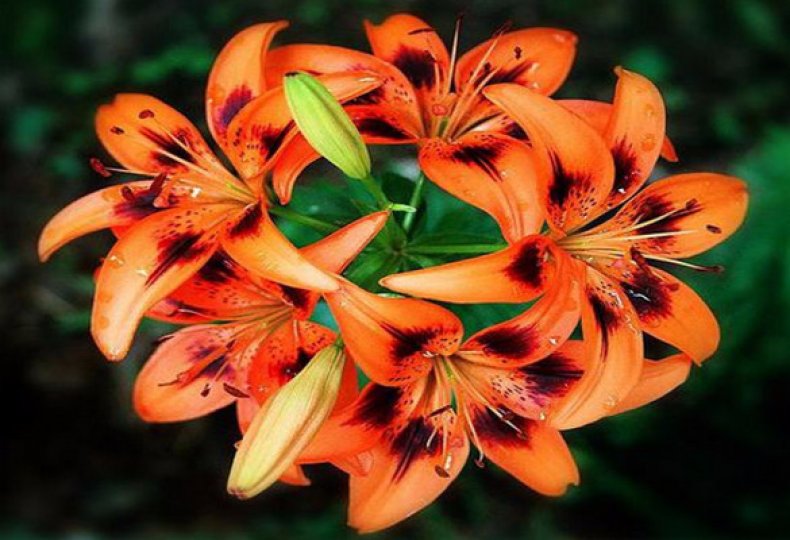Content:
Lilies occupy a well-deserved place in the gardens of amateur flower growers around the world. These are delightful, unpretentious flowering plants. Tiger Lily (Lanceleaf) is a bulbous perennial from the Liliaceae family with beautiful original flowers. She looks very exotic and attracts special attention.
Description of Tigrovaya lily
The homeland of the Tiger Lily is China and Japan. They began to cultivate this variety of lilies only in the 19th century, since the wild species did not take root well in amateur gardens. With the help of breeding work, it was possible to breed varieties and hybrids that do not require special growing conditions.
Garden Tiger Lily (Lilium lancifolium) grows up to 1.5-2 m. The stem is hard, tomentose, purple in color. The bulbs are large, white, ball or egg shaped. Leaves are sessile, narrow, lanceolate, alternate on the stem, dark green in color. The length of the leaves is up to 15 cm, the upper ones are shorter, small bulbs are formed in their axils, suitable for reproduction. These buds are the hallmark of the tiger lily, but in hybrids, their formation fades after a few years.
The inflorescence is racemose, loose, consists of 3-10 large bell-shaped flowers. The flowers are drooping, 10-12 cm long, on pubescent pedicels, almost odorless. The color is different, depending on the variety, they keep blooming for about a week. In wild lilies, it is orange, with bright specks on the inner surface. Blooms from July to September. The fruit is a capsule with numerous flat seeds. Flowering occurs in the 3rd year of the bulb's life.
Varieties and hybrids of tiger lily
Lily Night Flyer - large flowers (13-16 cm in diameter), showy. The color is deep burgundy with rare dark specks, turbid. The flowers are directed downward and to the sides. Height - 100-120 cm, blooms from July. It can grow both in the sun and in the shade.
Lily Fluffy Leopard - among Tiger lilies, the first variety with double flowers. Orange color with dark freckles, up to 30 petals in one flower, strongly bent back. On each peduncle, from 12 to 20 buds are formed. It is unpretentious in care, requires a sunny location.
Lily Citronella - flowers, 8-12 cm in diameter, rich yellow, with dark specks. Blooms for 20-25 days. Height - 100-130 cm.
Agricultural technology of cultivation
Growing this variety of lilies will not cause much trouble to the owner. The main thing is to immediately provide her with favorable conditions.
Landing place
The location is preferably sunny, but partial shade from the crown of the trees will do just fine. But without the sun, flowering can stop. There are no special requirements for soils, the main thing is that they are permeable. On light fertile soils, flowering will be especially bright and long-lasting. Lilies cannot stand stagnant water. The presence of drainage is mandatory; for this, a layer of sand is suitable directly under the bottom of the bulb. High humidity can kill the plant. If there is a hill on the site, this is the best place for a lily. A short-term drought is not as dangerous as flooding, but a lack of moisture will negatively affect flowering.Weak or neutral acidity is required, but lime is not needed when planting. If the soil in the area is acidic, it is better to add ash.
Landing
In areas with cold winters, lilies are planted in spring; to the south, you can plant in early September. The soil for planting is prepared in the fall. If the soil is heavy, it should be dug up, while adding sand. If the soil is light, then deep enough (up to 30 cm) loosening with a pitchfork or flat cutter. Acidic soil must be neutralized with ash. From fertilizers under the Tiger Lily, the following substances are applied:
- humus - a bucket per sq. m;
- superphosphate - 100 g per sq. m;
- potassium salt - 50 g.
Instead of the indicated ingredients, you can use complex mineral fertilizers containing necessarily phosphorus and potassium. At a distance of 20x20 cm, you need to dig planting holes for a lily, 20 cm deep. At the bottom of each hole, pour a thick layer of river sand. Lower the bulbs into the resulting holes, carefully cover with soil and water abundantly. In the first year after planting, the lily needs to be covered for the winter. To do this, you can use mulch and spruce branches, cover with snow as soon as possible.
Care
Caring for Tiger Lilies is not difficult, since all varieties and hybrids of this variety are quite unpretentious. It needs to be watered regularly, but without allowing water stagnation. The culture requires especially frequent watering at the time of budding and flowering. After the end of the flowering period, watering must be stopped, so the bulb will quickly prepare for winter. You need to feed the lily at least three times per season. The first feeding is done in the spring with nitrogen fertilizers. The second - in July, the last time - after flowering, closer to winter, with phosphorus-potassium fertilizer.
Major diseases
The tiger lily is a carrier of the mosaic virus, which manifests itself in atypical spots on the leaves. For her herself, this virus does not threaten anything, but for plants growing nearby it can be dangerous. On strongly alkaline soils, lilies can develop chlorosis; to prevent this, peat, needles or sawdust are added to the soil.
Reproduction
You can propagate the Lanceleaf lily with bulbs, bulbous babies, scales and seeds. The simplest are vegetative reproduction methods:
- Breeding lilies with buds (bulbs) is a simple and effective way. In the axils of the leaves of many varieties of Tiger Lily, at the end of flowering, so-called air bulbs are formed. Several dozen such bulbs can form on one stem per season. Ripe bulbs have roots (perhaps even leaves) and are easily separated from the stem. It is necessary to collect the bulbs immediately after ripening in August-early September, as they crumble and germinate randomly.
Before planting, the soil should be dug onto a shovel bayonet and mineral fertilized. They need to be planted to a depth of 2-3 cm with an interval of 5 cm between the bulbs and 20 cm in a row. Water, from above you need to mulch the plantings with peat or humus. Each variety must be planted separately so as not to get confused later. You can plant buds in the spring, after warming up the soil. Before that, they are stored in the cold (you can in the refrigerator) in dry sand or sawdust. After germination, you need to care for the seedlings as usual: water, gently weed and feed. The grown bulbs are transplanted to a permanent place. They begin to bloom the next year, but it is advisable to remove the buds so that the bulbs are strong enough.
- Lilies reproduce very easily by children of five-year-old lilies. When transplanting a lily, you can separate the daughter bulbs. They are planted in a garden bed. You need to take care of the same as for the bulbs. As a result, full-fledged bulbs will be obtained next year.
- When propagated by scales, from one bulb can grow from 20 to 150 new copies. To do this, select a large healthy bulb and separate the scales by pressing a finger on the base. Whole flakes are washed and placed in a potassium permanganate solution for 30 minutes. Then they are dried and placed in moist moss, then put in a bag and placed in a dark place. After 6 weeks, small bulbs should form. Then they are transferred directly in the bag to the refrigerator for a month. After that, the bulbs are separated from the scales. Disembarkation is carried out directly into open ground or boxes.
Growing a Tiger lily is not difficult. She is beautiful, unpretentious and has good protective qualities. With proper care, it looks just gorgeous. This variety of lilies will appeal to both novice flower growers and experienced lovers of ornamental plants.















